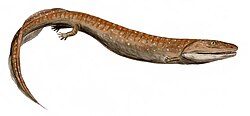| Cladarosymblema Temporal range: Early Carboniferous | |
|---|---|
 | |
| Skull and pectoral girdle | |
| Scientific classification | |
| Domain: | Eukaryota |
| Kingdom: | Animalia |
| Phylum: | Chordata |
| Clade: | Sarcopterygii |
| Clade: | Tetrapodomorpha |
| Clade: | † Megalichthyiformes |
| Family: | † Megalichthyidae |
| Genus: | † Cladarosymblema Fox et al., 1995 |
| Species: | †C. narrienense |
| Binomial name | |
| †Cladarosymblema narrienense Fox et al., 1995 | |
Cladarosymblema is an extinct genus of megalichthyid tetrapodomorphs which lived in Australia during the Early Carboniferous.





